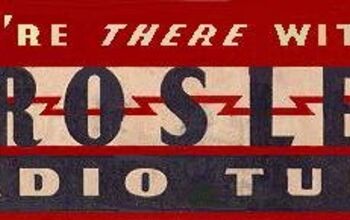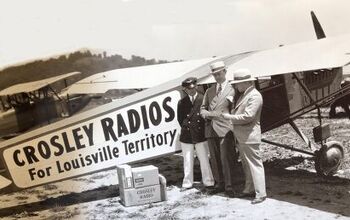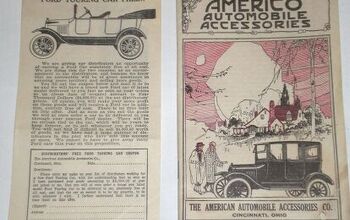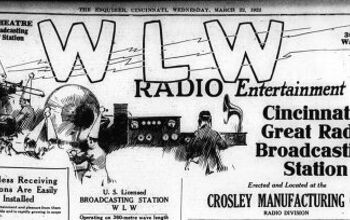Rare Rides Personas: Powel Crosley Junior, Tiny Cars, Radio, and Baseball (Part I)

Welcome to a new series in the Rare Rides universe, where we’ll spend some digital ink considering the humans behind the automobile experience. This series will focus on the life and times of the industrialists, inventors, engineers, tycoons, and the like who decided to devote a portion of their life to the automobile, whether intentional, accidental, or against their will. Ideally, we’ll proceed with personas first, and then cover their automobiles in a Rare Rides or Icons series.
Our first Rare Rides Personas subject is Powel Crosley Jr., a well-known native of your author’s present city, Cincinnati, Ohio. Commenter Jeff S suggested some Crosley coverage back in May, and here we are a couple of months later with the launch of an all-new series. Onward, to Crosley!
Powel Crosley Jr. was born September 18, 1886, in the rapidly growing river city of Cincinnati, Ohio. Powel was the eldest child of Powel Crosley Sr. (1849-1932) and Charlotte Wooley (1864-1949). The family was not without means, as Crosley’s father was a local attorney. He spent his entire 56-year law career practicing in Cincinnati and was still in practice at age 83, a few weeks before he passed.
Crosley Sr. was interested in the law, the Republican party, the theater, and the newfangled technology of radio. He held a permanent lease on the Pike Opera House and ran Pike’s Theatre until the building burned down in 1903. With an interest in the earliest days of radio, at the turn of the century, he invested in the original Marconi Wireless Telegraph and Signal Company. He also bought his son a radio set as a child, an action that would have a profound effect on the boy’s life.
Crosley Jr. was the eldest of four children in the family, who lived north of downtown Cincinnati in an upper-middle-class part of the College Hill neighborhood. In Crosley’s downtime between school and playing with his radio, he became interested in the mechanical workings of cars. The automobile was still in its infancy at the turn of the century, but from a very young age, Crosley was determined to make a car.
And that wasn’t just a childhood dream. At the age of 12, Crosley attempted to build his first car on the family’s property in College Hill. Crosley’s father was amused by the effort, and bet his son $10 that his car would not be complete, or actually work. Ten dollars was not a small amount of money in 1898, that sum adjusts to $357 today.
With the stakes high, Powel asked his younger brother Lewis (1888-1978) for some assistance in completing the project. Lewis brought mechanical skills and some parts funding to the project. Crosley first turned to his grandfather to borrow a simple flatbed horse-drawn wagon and begged a battery from a local theater company. Perhaps the most impressive part of the car - its electric motor - was a bespoke design that Powel and his brother built by hand.
Though it was a crude design, the first Crosley car was an open-air EV flatbed pickup. Like many early automobiles, it had a tiller instead of a wheel. And the completed car did work. Its first journey was one block each way, to the local post office and back. It’s important to pause here for a moment, and consider that two children ages 12 and 10 designed and constructed a working EV on their own.
Eyebrows raised, Powel Sr. handed over the cash. With dad’s $10 in hand, Powel Jr. repaid Lewis, his grandfather, and the theater, and split the two dollars of profit with his brother. Build a car, impress your father, and make $35 in the process? That’s a win. The car was the first of many projects Powel and Lewis would work on together in the decades to come.
Crosley Jr. maintained his interest in automobiles and certainly found them more interesting than school, sports events, or hunting. His brother Lewis would often say “The only reason [Powel] became rich was so he could build automobiles.” But his age and schooling got in the way of his car dreams, and he started high school around 1900. Initially, he went to public school in College Hill but transferred to the Ohio Military Institute in Cincinnati.
The private school was very forward-looking for its time and prepared high school students for higher education via practical learning on technical and industrial subjects. Such an education was fitting for Crosley, and he finished the remainder of his secondary education there before enrolling at the University of Cincinnati in 1904. The college was located very close to his family home and was convenient. UC remains in College Hill today, with an enrollment of over 28,000 in 2020.
Naturally, Crosley enrolled in the engineering program at the university. But even though engineering was a subject of interest to Crosley and something in which he had skill, he nearly flunked his early classes. Additional pressure arrived from his father.
Though Powel Sr. encouraged his son’s early mechanical pursuits in radio and automobiles, he felt his eldest would live his best professional life as a lawyer. Crosley switched to the law program at UC to keep his father happy. But Powel was not especially interested in higher education, doubly so when he was forced to study the law. He dropped out in 1906 after two years of coursework.
Without a degree, Crosley took his first job at an investment banker’s office where he did paperwork and sold bonds. Then 20 years old, thoughts of the automobile still filled his mind. The banking job lasted a very short while: After he turned 21, he decided he would pursue his true passion, and make an automobile. Crosley declared he was going to “take a swing at the world.” Full of youth, enthusiasm, and without much real-world experience, Crosley wanted to launch a car company.
It seemed a promising time to do so, as while Crosley was in high school mass production of the automobile became a reality. Crosley was intensely interested in the assembly lines of Ford and interchangeable parts, both of which came together in the first mass-produced car ever, the Oldsmobile Curved Dash of 1901. This new reality intensified Crosley’s desire to start a car company, and in particular a luxury car.
In 1907, Crosley made the first steps to realize his luxury motorcar dream. He started a firm called the Marathon Motor Car Company, and went looking for funding. But how many people were eager to fund a luxury car start-up with a 21-year-old dropout as its sole proprietor? More than you’d expect, apparently. We’ll pick up right there in Part II.
[Image: Crosley]
Become a TTAC insider. Get the latest news, features, TTAC takes, and everything else that gets to the truth about cars first by subscribing to our newsletter.

Interested in lots of cars and their various historical contexts. Started writing articles for TTAC in late 2016, when my first posts were QOTDs. From there I started a few new series like Rare Rides, Buy/Drive/Burn, Abandoned History, and most recently Rare Rides Icons. Operating from a home base in Cincinnati, Ohio, a relative auto journalist dead zone. Many of my articles are prompted by something I'll see on social media that sparks my interest and causes me to research. Finding articles and information from the early days of the internet and beyond that covers the little details lost to time: trim packages, color and wheel choices, interior fabrics. Beyond those, I'm fascinated by automotive industry experiments, both failures and successes. Lately I've taken an interest in AI, and generating "what if" type images for car models long dead. Reincarnating a modern Toyota Paseo, Lincoln Mark IX, or Isuzu Trooper through a text prompt is fun. Fun to post them on Twitter too, and watch people overreact. To that end, the social media I use most is Twitter, @CoreyLewis86. I also contribute pieces for Forbes Wheels and Forbes Home.
More by Corey Lewis
Latest Car Reviews
Read moreLatest Product Reviews
Read moreRecent Comments
- Dale Quelle surprise.
- 3SpeedAutomatic Nice looking, but IIRC, there was an issue with these engines where a knock would develop. That may account for the very low milage. 🚗🚗🚗
- Redapple2 Used to watch F 1 a great deal. Now? F1 Random thoughts:1 Silly rules bug me. Must use 2 types of tire. Cant refuel. Drag reduction can only be used in certain areas of the track and only if you are so close to the car in front.2 Passing is rare. Pole sitter wins a high % of the time.3 A new team can only start in F1 if they get the blessing of the overlords. Evil gm Vampire was barred. How about this. Anybody with a car that meets the construction rules can try. If your speed qualifies and you pay the entry fee. You re in. So is anybody else. 4 I tune in for Martin Brundle's grid walk. In my life, it s must see tv. But he is often bumped or cancelled. Grid walk takes place 1 out of 3 or 4 races.5 So, because of this utter bull sheet and other points, I ve migrated to IMSA and MotoGP. I might catch a summary on the youtube.
- Redapple2 I retract my comments and apologize.
- Flashindapan I always thought these look nice. I was working at a Land Rover dealership at the time the LR3 came out and we were all impressed how much better it was then the Discovery in just about every measurable way.


































Comments
Join the conversation
Glad to see Crosley getting his due. Maybe not a genius but a great innovator. It's a shame that his company, which was hugely successful, just sort of faded away.
One quibble - UC is not in College Hill but in Clifton, or more properly University Heights.
Corey--Thank you so much for writing about Powell Crosley. So much history is lost and especially in Cincinnati many younger native born Cincinnatians no nothing about Crosley, King Records, and many of the important contributions that have been made that effect everyone. Powell Crosley was very much ahead of his time especially with the Crosley car which was a small, affordable, and efficient car. Crosley was the first to put shelves in the doors of refrigerators and was the owner of the Cincinnati Reds for many years which is where the name of Crosley Field before the Riverfront Stadium which was replaced as well. Looking forward to this series on Crosley. You always do an outstanding job on all your series.